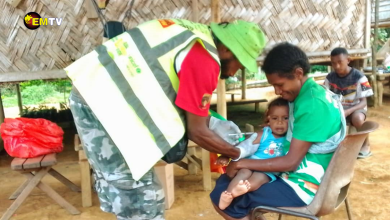New H7N9 bird flu strain in China has pandemic potential: study
Image: FILE PHOTO: Health officers cull poultry at a wholesale market, as trade in live poultry suspended after a spot check at a local street market revealed the presence of H7N9 bird flu virus, in Hong Kong June 7, 2016. REUTERS/Bobby Yip/File Photo

By Julie Steenhuysen
CHICAGO (Reuters) – Lab experiments on a new strain of the H7N9 bird flu circulating in China suggest the virus can transmit easily among animals and can cause lethal disease, raising alarm that the virus has the potential to trigger a global human pandemic, researchers reported on Thursday.
The H7N9 virus has been circulating in China since 2013, causing severe disease in people exposed to infected poultry. Last year, human cases spiked, and the virus split into two distinct strains that are so different they no longer succumb to existing vaccines.
One of these has also become highly pathogenic, meaning it has the ability to kill infected birds, posing a threat to the poultry industry.
U.S. and Japanese researchers studied a sample of this new highly pathogenic strain to see how effectively it spread among mammals, including ferrets, which are considered the best animal model for testing the transmissibility of influenza in humans.
In the study published in Cell Host & Microbe, flu expert Yoshihiro Kawaoka of the University of Wisconsin and colleagues tested a version of the new H7N9 strain taken from a person who died from the infection last spring.
They found that the virus replicated efficiently in mice, ferrets and non-human primates, and that it caused even more severe disease in mice and ferrets than a low pathogenic version of the same virus that does not cause illness in birds.
To test transmissibility, the team placed healthy ferrets next to infected animals and found the virus spread easily from cage to cage, suggesting the virus can be transmitted by respiratory droplets such as those produced by coughing and sneezing.
Two out of three healthy ferrets infected in this way died, which Kawaoka said is “extremely unusual,” suggesting that even a small amount of virus can cause severe disease.
“The work is very concerning in terms of the implications for what H7N9 might do in the days ahead in terms of human infection,” said Michael Osterholm, an infectious disease expert from the University of Minnesota.
Since 2013, the H7N9 bird flu virus has sickened at least 1,562 people in China and killed at least 612. Some 40 percent of people hospitalized with the virus die.
In the first four epidemics, the virus showed few changes. But last flu season, there were some 764 cases – nearly half of the 1,562 total.
“The whole world is worried about it,” Osterholm said.
A new risk assessment tool from the U.S. Centers for Disease Control and Prevention (CDC) ranks H7N9 as the leading animal flu strain with the potential of causing a human pandemic.
The most recent global pandemic was the 2009 H1N1 swine flu outbreak that infected millions and killed more than 200,000 globally.
Some researchers are concerned that the highly pathogenic strain could cause even more severe disease and higher death rates, but mortality from the low pathogenic strain is already “alarmingly high,” said Dr. Timothy Uyeki, a CDC flu expert.
Existing H7N9 vaccines are based on the 2013 strain. The CDC has developed a new vaccine based on the low pathogenic strain of the mutated virus, Uyeki said. The low pathogenic strain accounted for most of the human infections last year.
Uyeki believes the vaccine would likely also offer protection from the new highly pathogenic H7N9 strain, but it needs to be tested in people.
In February, China gave the go ahead for clinical trials of H7N9 vaccines developed by state-owned Beijing Tiantan Biological <600161.SS>. The company said in a filing that it was developing four vaccines against the H7N9 virus.
(Reporting by Julie Steenhuysen; Additional reporting by Adam Jourdan in Shanghai; Editing by Toni Reinhold)
Copyright 2017 Thomson Reuters. Click for Restrictions.






